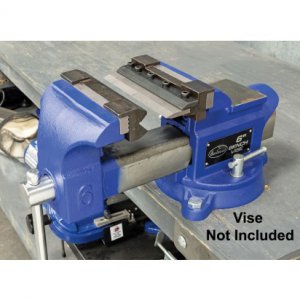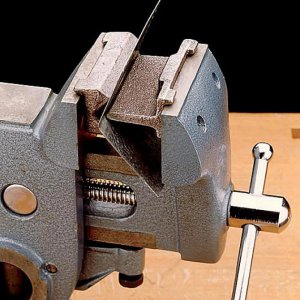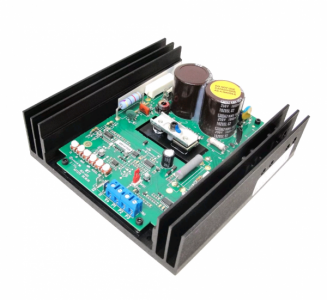- Joined
- Jul 18, 2017
- Messages
- 407
Hi guys,
As many of you already know, I have a 1 car garage that is stuffed with woodworking and metalworking equipment. So, I have been looking for ways to save space, lol.
I have found, on a couple of different websites, a nifty space saving gadget. It is a finger brake that is mounted onto your vise. What I like about it is that you can bend metal that is longer than the vise jaw width if you just bend one section then scoot it to the next section to bend, etc.

I read off of one instruction manual to never use the finger brake on vise jaws that are smaller than the brake length.
I found one site selling a vise mounted finger brake that is 8 inches wide. My widest machinist vise's jaws are 5 inches. However, I also have an old Columbian woodworking vise (mounts on underside of bench) that has 10 wide jaws. It's pretty heavy duty, and weighs 33 lbs. Plus, being a woodworking vise, it's got a much deeper "throat" than my 5" bullet vise (if it matters, my 5" is around 95 lbs, I think).
If you look at examples of this vise finger brake bending sheet metal, it looks like the advantage of having a deeper vise throat is that the bend can be made further from the edge, if the vise has room, but I could be wrong.

In advance, sorry for all these questions
***Do you guys think a woodworking vise would be just as effective as a mechanics/machinists with these vise finger brakes?**
**Do you think, based on the design of the finger brake, that a deeper throat depth has limited advantages with a 90 degree bend**
**If you had to choose, would you use the 10" Columbian woodworking vise, or the 5" Wilton bullet vise?**
I would primarily use such a finger brake for making enclosure boxes for my various motor control chassis' and for the control box that would have the on/off switch, speed display, etc. Here is a pic of one model chassis I plan on using with a treadmill motor:

It would also be nice to have something heavy duty in case I need to bend something thicker than sheet metal, but space is an issue.
Here are links to a couple of sites selling such gadgets:
https://www.princessauto.com/en/detail/8-in-vise-mount-bending-brake/A-p8663775e
https://www.eastwood.com/eastwood-6-inch-vise-press-brake.html
Thank you!
Susan
As many of you already know, I have a 1 car garage that is stuffed with woodworking and metalworking equipment. So, I have been looking for ways to save space, lol.
I have found, on a couple of different websites, a nifty space saving gadget. It is a finger brake that is mounted onto your vise. What I like about it is that you can bend metal that is longer than the vise jaw width if you just bend one section then scoot it to the next section to bend, etc.

I read off of one instruction manual to never use the finger brake on vise jaws that are smaller than the brake length.
I found one site selling a vise mounted finger brake that is 8 inches wide. My widest machinist vise's jaws are 5 inches. However, I also have an old Columbian woodworking vise (mounts on underside of bench) that has 10 wide jaws. It's pretty heavy duty, and weighs 33 lbs. Plus, being a woodworking vise, it's got a much deeper "throat" than my 5" bullet vise (if it matters, my 5" is around 95 lbs, I think).
If you look at examples of this vise finger brake bending sheet metal, it looks like the advantage of having a deeper vise throat is that the bend can be made further from the edge, if the vise has room, but I could be wrong.

In advance, sorry for all these questions
***Do you guys think a woodworking vise would be just as effective as a mechanics/machinists with these vise finger brakes?**
**Do you think, based on the design of the finger brake, that a deeper throat depth has limited advantages with a 90 degree bend**
**If you had to choose, would you use the 10" Columbian woodworking vise, or the 5" Wilton bullet vise?**
I would primarily use such a finger brake for making enclosure boxes for my various motor control chassis' and for the control box that would have the on/off switch, speed display, etc. Here is a pic of one model chassis I plan on using with a treadmill motor:

It would also be nice to have something heavy duty in case I need to bend something thicker than sheet metal, but space is an issue.
Here are links to a couple of sites selling such gadgets:
https://www.princessauto.com/en/detail/8-in-vise-mount-bending-brake/A-p8663775e
https://www.eastwood.com/eastwood-6-inch-vise-press-brake.html
Thank you!
Susan
Last edited:
